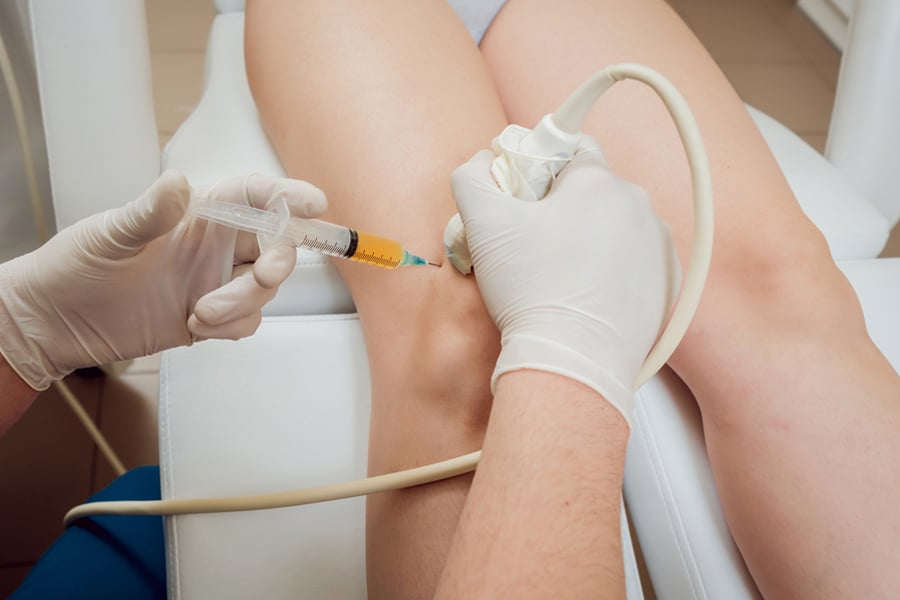Platelet-rich plasma (PRP) is a regenerative treatment that is being used for a variety of conditions. It involves using one’s blood to create a heavily-concentrated solution of platelets that is injected back into the body. The process has proven to be effective in decreasing the length of time needed for the body to naturally recover.
Overview of Blood Composition
Our blood is composed of various types of cells. Some of these include the following:
- Plasma: A liquid that contains water and various types of proteins
- Red blood cells: Carry oxygen throughout the body
- White blood cells: Are critical in preventing infections
- Platelets: Also known as thrombocytes, these platelets allow the blood to clot and promote healing
Separation Process
The whole blood is extracted and put into a centrifuge. This is a device that spins rapidly and separates the components within the blood. This process may only take roughly 15 minutes.
Current Development in PRP Treatment
The worldwide PRP market exceeded $214 million in 2016 and continues to grow by more than 10% annually. This treatment is now being used in orthopedics, sports medicine, plastic surgery, and various cosmetic applications. The growth of PRP treatment in the upcoming years is may involve treating the large geriatric population and in dental health.
Precautions Before a PRP Injection
Patients that are preparing for PRP injections should always follow the instructions of their medical provider. Your doctor should be informed of any prescription or over-the-counter medications that you regularly use. Some medications that thin the blood can prolong bleeding. These include aspirin, ibuprofen, and anticoagulant medications.
Get Back Your Normal Life Again
As pain specialists, we can guarantee that we are more than qualified in alleviating your pain and treating your condition.
In surgical applications, you should follow the pre-surgical recommendations provided by your doctor. In some cases, a local anesthetic or numbing agent such as lidocaine may be used to minimize discomfort. As with any procedure that involves drawing blood, you should eat a meal earlier in the day to prevent lightheadedness.
Potential Side Effects
Compared to many procedures, a PRP injection generally has mild side effects. Some patients may experience minor pain, swelling or inflammation. It is very unlikely that any allergic reaction would occur. This is because the injection contains substances from your own body.
When to Immediately Seek Medical Attention
Some symptoms may indicate a potentially dangerous problem. Minor bleeding is fairly common. Place and hold an ice pack on the injection site for 10 minutes. If significant bleeding persists, contact your physician promptly.
Some other signs may suggest that an infection exists. Having a body temperature that exceeds 100 is a potential sign. Watch for any excessive drainage from the region or any strong odors. Feelings of numbness or excessive muscle weakness may indicate potential damage to the nerves.
Post-Injection Precautions
Most people that undergo PRP treatment do so in an outpatient setting and can resume their normal daily routine.
- Pain or swelling: Mild feelings of pain or some minor swelling is common. An ice pack applied for minutes at a time may help in minimizing these effects. Depending on the circumstances, a doctor may recommend applying heat to the region instead. Acetaminophen (Tylenol) should ease most discomfort.
- Washing and bathing: If possible, avoid washing the area of the injection site for at least 24 hours. This also applies to the use of hair and skincare products. Those who have an injection in the spinal region should avoid submerging the injection site for 72 hours. When applicable, avoid using hair coloring products for one week.
- Periods of rest: When the injection is for treatment of a joint it is best to rest for several days and avoid straining the area near the affected joint. If necessary, you may immobilize the region by using a sling, braces, crutches, etc. When the injection occurs in soft tissue, such as tendons or ligaments, the area may need several weeks of rest. Injections occurring in the spinal region are likely to require a longer period of rest. (see your doctor for details)
- Pain medication: Anti-inflammatory medications may need to be avoided for several weeks. Some examples include ibuprofen and naproxen. Typically, acetaminophen is the preferred treatment for pain following these injections.
- Blood thinners: Products used to thin the blood (anticoagulants) may also not be recommended following an injection.
- Corticosteroid medications: Examples of these medications include cortisone and prednisone. They may harm the stem cells. It is important to remember to always follow the instructions given by your medical provider.
Post-Injection Expectations
PRP injections are unlikely to have noticeable results immediately. They generally promote the process of healing that occurs for weeks or months.
Experienced Medical Provider for Platelet Rich Plasma (PRP) Treatment in Arizona
At the Arizona Pain and Spine Institute, we have the necessary skills and expertise to effectively treat most painful conditions. Our team of professionals uses a comprehensive approach that employs the latest advancements in medical technology and healing techniques. Contact the office today at (480) 986-7246 for an appointment.

